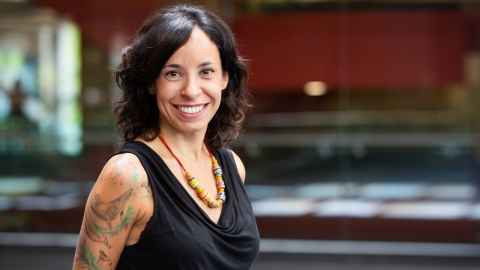Lecturer Gabriela Baron discusses women in design and how the menstrual cup changed her life!
6 March 2020
We’ve come a long way since the first International Women’s Day in 1975. However, we mustn’t lose sight of the majority of the world’s women who continue to live without equal rights.

In keeping the debate alive, we caught up with Dr Gabriela Baron, lecturer and researcher for the University of Auckland’s new Design Programme, to hear about her career story, challenges and advice for women.
Tell us a bit of your backstory
“My name is Gabriela Baron and I was raised in the Patagonia region, Argentina. When I was five my parents and I moved to Madrid and after some years on to New Jersey. When we moved back to Argentina I decided to study industrial design, and once I graduated I began making custom-made high-end wine cellars!
“Wanting to return to Europe and continue my studies, I applied for (and was awarded) a grant to study a Masters in Product Service System Design in Milan. I also wanted to travel and have fun, so I backpacked across Europe by myself and learned a lot about life. In Milan I discovered design for sustainability, which was far more out there that the eco-design babble I was used to. This was definitely a before and after moment for me."
I never went back to designing furniture for rich people; I could only ‘design for purpose’ thereafter. I had found my passion.
“I taught social innovation for some time in Milan. I also volunteered to teach children in Cambodia, while diving and cleaning up the ocean little by little. I then enrolled in an Environmental Engineering PhD in Argentina which, though very challenging, opened many doors for my future."
Have you been through any particular challenges for being a woman in a predominantly male industry?
“While researching for my PhD I met my husband-to-be and I became a mum. This was the hardest thing I have ever done in my life. Becoming a mum of two girls, while teaching and studying challenged all my beliefs, my body, my health and my ways of thinking about life. I faced many crises, put myself and my family under a lot of stress, and came very close to having an emotional breakdown. The supermom model was proving to be very impractical for me. I felt I was failing as a mother, as a professional and as a human being.
“On the other hand, this great crisis led me to a self-re-design journey. A very honest and scary process. Since then, I have been on a path to reconnecting to my feminine side, the motherly side, the side that pushes me to self-care, self-love and self-compassion as the only path for a fulfilling, wholesome life."
What advice would you give to female designers who are just starting up?
“You are coming to the right profession at the right time. Design has all the potential to save the world, but it requires commitment, real passion and strength. Challenge everything: no more trying to fit as we ladies are accustomed to, follow your intuition and don’t be afraid to shine."
What advice would you give to younger you?
“You are perfect. Love yourself. One of our innate gifts as women is that we are able to empathise and listen deeply. We listen with our entire selves as instruments of intuition. Don’t ever underestimate this. These are your superpowers."
Don’t let the world force you into becoming more masculine to succeed in a boy’s world.
Which female designers have inspired you?
“Leona Chalmers. She invented the menstrual cup in 1937. This is a reusable, feminine hygiene product which Chalmers designed to collect menstrual flow from the vagina. Before her invention, the only reusable options were metal cups or flexible sacks which were very painful and unhygienic.
“At the time, generation after generation were being taught by the big tampon and sanitary pad companies that their products were the best in feminine hygiene. Yes, those that you buy, use and dispose of every month. Well, it turns out they were wrong. The menstrual cup from 1937, originally made from latex rubber and now from silicone, is long-lasting; it’s comfortable and super-healthy with no harmful chemicals in contact with your lady parts, and no disposable garbage filling up landfills. It is a safe, effective and sustainable, eco-friendly design. Bearing in mind that Chalmers designed this product at a time when talk of periods and vaginas was shrouded in shame and scandal, she is undoubtedly an inspiration."
“If you haven’t tried it yet, get comfy with the menstrual cup because it has really changed my life and could change yours too!”